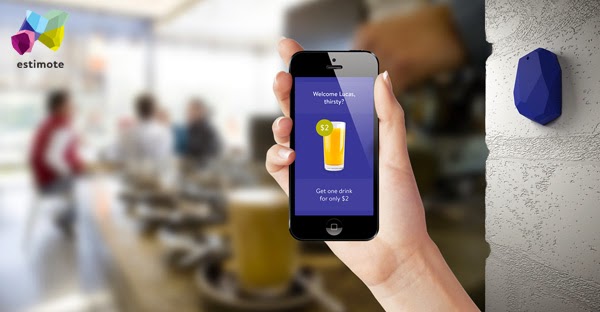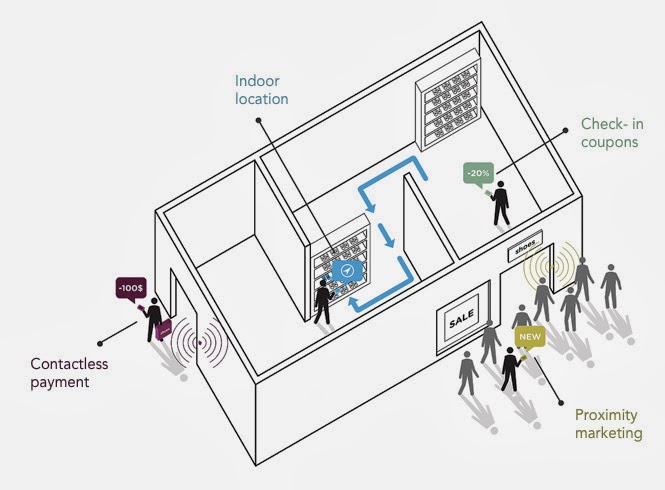This post explores iBeacons. It may have been announced only quietly, but it is going to have a big impact on how we perceive computing, and on the so-called Internet of Things.
iBeacons technology is being promoted as a service, particularly for innovative brick-and-mortar retailers to differentiate via micro-location, context-aware apps and analytics. However the technology has an equally powerful reductive effect on privacy, for those who choose not to be conscientious and self-impose limits.
This post focuses on the technology. I'll be covering what an Estimote Beacon is, what other types of Beacons there are, and how you can make your own. I'll go on to talk about how iBeacons is giving NFC a run for it's money.
This post also disassembles the overloaded term iBeacon, which can be a little confusing at first when you hear it used to describe many different pieces of a larger puzzle.
A Word on Privacy
I've focused mostly on technology in this article, but I want to take a moment to comment on privacy. iBeacons make it possible to easily engage with people in a physical space via their mobile devices. But part of what will make the experience so compelling is the ability to triangulate the precise physical position of each participant. And as long as the person has Bluetooth enabled and your app installed, it will be possible to do this without their permission.
The old adage fits here, that just because you can do a thing doesn't mean you should do a thing. Permission is key. It's not just on moral grounds, but on grounds of building trust. If I enter into a space where beacons are active, I want to be told what value I can expect, and what data I am giving away to get that value. Once I opt in, I am engaged. If I choose not to opt in that should be respected.
There is also a distinction between using real-time data and storing real-time data. But ultimately this technology is out there right now, and people are going to start using it. We must be aware of privacy concerns and go ahead and learn about the technology. That's what this article is for.
What is an Estimote Beacon?
An Estimote Beacon is a device made by a Polish company that utilizes a newly-available mode in Bluetooth called Bluetooth Low Energy (BLE). Later in this article I will describe the iBeacons service on your phone, and alternative Beacon services, but first let's focus on the now well-promoted Beacon called Estimote, and the interactions it can provide.
In the picture below, the Estimote Beacon is broadcasting using BLE. The phone receives the broadcast information over it's own BLE, and the beacon-enabled app recognizes the user's proximity to the beacon. In this case, the beacon is positioned near a bar, and the user is offered a discount on a favorite drink. The favorite drink is identified by the user's purchase history, retrieved via the app.
As the name infers, BLE communicates in a similar manner to regular Bluetooth, but consumes much less power, meaning that the Estimote Beacon can run for 2 years on a tiny coin battery. If your phone supports BLE, and Bluetooth is enabled, beacon-enabled apps can work out your proximity to a beacon. If there are several beacons, the app can use the relative strength of the beacon signals to work out your precise location. The app can use this information to send push notifications and deliver context-relevant experiences to your phone.

The canonical example is a retail store and merchandise stands. When people enter a space or visit certain stands they can be sent targeted information - text and small images, or linked to online rich media such as video or sound. This could be promotions, coupons, recommendations, marketing or informational content, and if there is an app running on the shopper's device and they are logged in, this can be personalized.
There can also be mashups, for example the micro-location equivalent of Google Maps. Users can search for a particular item and be guided to it's precise location, across the shop floor, up the elevator and so on. Ultimately, this is an early-stage technology and the possibilities are open.

There is also the possibility for those with logged-in accounts to have contactless payment on leaving the store, since we know exactly when users are leaving. More on an alternative way of doing that with a PayPal dongle below.
Analytics
One other feature which will be coveted by many retailers is the ease with which you will be able to track visitor's precise movements through a store. This brings web-style analytics that much closer to physical retail, as we are able to get quantitative data on more and more details of people's interactions with store merchandise.
As discussed earlier use of this feature should be approached openly and in an opt-in fashion. Notice the people in the 'Proximity Marketing' section of the image above? These interactions should be handled delicately.
What is/are iBeacons?
Bluetooth Low Energy (BLE), mentioned earlier, is part of the Bluetooth Specification 4.0 (aka Bluetooth Smart). This flavour of Bluetooth is now available on many phone and tablet devices, and has been baked quietly into iOS7. Most new devices will be BLE compatible:
"The majority of new devices entering the market, including the HTC One, Nokia Lumias, Samsung Galaxy Nexus and the Blackberry Z10 and Q10, among others, are all BLE compatible. In terms of iOS devices, the iPhone 4S and above, the iPad with Retina display and the iPad mini are all BLE compatible."
Source - Mubaloo
This feature of Apple devices and the services that go with it have been named iBeacons, in classic Apple 'iThing' style. But the term iBeacon has become overloaded. I have seen it used in the following contexts:
- a generic term for a physical beacon in real space, such as an Estimote Beacon
- the software platform in iOS7 which allows Bluetooth 4.0 hardware to use BLE and talk to beacons
- the overall service, including the two cases above as one (referred to plurally as iBeacons)
And that's just with iOS, where the term originated.
Who else is in this Space?
Following closely behind Apple are Android equivalents to all of the above, and many times the naming includes the term iBeacon in a me-too fashion. Radius Networks, a start-up out of Washington D.C. offer physical iBeacons ($99), and an Android SDK to allow developers to write apps for compatible devices, which they refer to as the Android iBeacon Service.
The physical iBeacons by Radius are just a customized Raspberry Pi, which tells you something about the nature of the service - all you need to get going with this is a Bluetooth 4.0 dongle and something to run free software on.
A San Francisco-based startup called COIN offers an Arduino-based beacon for $22. In the same vein, you can make your own Beacon out of a Raspberry Pi and a Bluetooth 4.0 dongle.
PayPal have a strong presence in this space, having developed a Beacon-as-USB-dongle. You guessed it, this is just a Bluetooth 4.0 dongle for a retailer's laptop, with some bundled PayPal software. From a customer's perspective:
"By checking in to a store à la Foursquare (you can even configure the app check you into places automatically), that retailer has access to the funds in your PayPal account and you can pay for your items directly with that money. It's proximity-based, so you do have to be physically present at the store. The security check happens when the retailer is shown a picture of your face to make sure that you're who you say you are. With that confirmed, your total purchase is deducted from your PayPal account."
Source - Business Insider
And there is one more iBeacon. It's a phone accessory on kickstarter which was unfortunate enough to have labeled all their hardware with the iBeacon name. And has just had that name usurped...
What are Virtual Beacons?
An Estimote Virtual Beacon is a free iOS app that turns your iWhatever into an iBeacon using it's existing BLE hardware (app released Sep 19). With it, you can set up one iPhone as an iBeacon, position it, and use it to track another. A whole iPhone is a bit heavy to serve as just a beacon, but it's useful for testing and playing with the SDK.
Of course, hot on the heels is an Android version (Oct 17), called iBeacon Locate, also by Radius Networks. To use these apps your phone will need to support Bluetooth 4.0, as described above. In the case of Android, this means you will need to be running Android 4.3.
You can also run an iBeacon on a virtual machine, although I'm not sure yet why you would want to do that...
What are the Implications for NFC and RFID?
NFC is RFID's younger cousin, which offers contactless payment and data exchange at short (4cm-ish) distances. Apple stalled for a long time when it comes to including NFC reader hardware on their devices, to the frustration of NFC advocates. On the other hand, many Android devices support NFC and for a while there was a question as to why Apple wasn't jumping on board.
Now we know. Apple is betting on BLE, because as well as winning on cost and range, BLE is already cross-platform. Apple have played their hand against NFC.
But RFID is bigger and more established than NFC. And it does things that iBeacons doesn't do. Humans may carry phones but physical objects don't! In-store merchandise, warehouse stock, any physical objects will be better served by RFID tags. Merchandise tracking is still a key area for RFID, and that translates in-store too. When I pick up a shirt and carry it to a changing room, this interaction will not be visible to any iBeacon.
If you want to use technology to offer participants a full experience including smart interactions with objects beyond localized areas like merchandising stands, you may want to consider a mixed solution involving RFID and iBeacons.